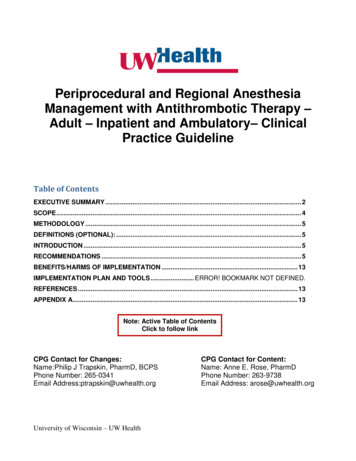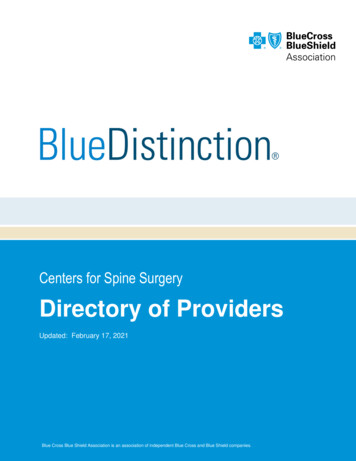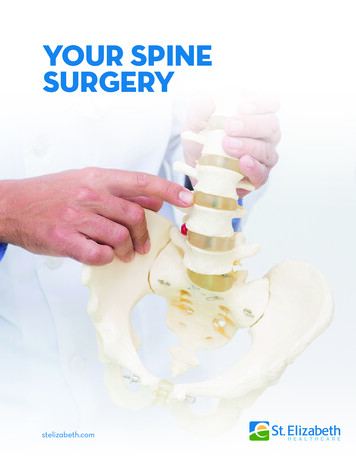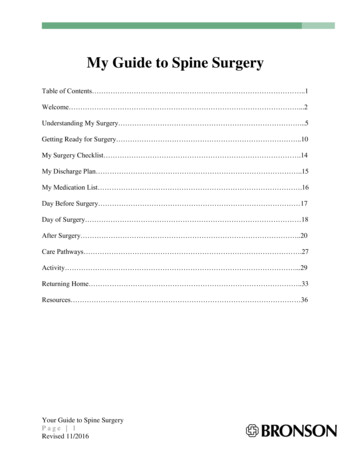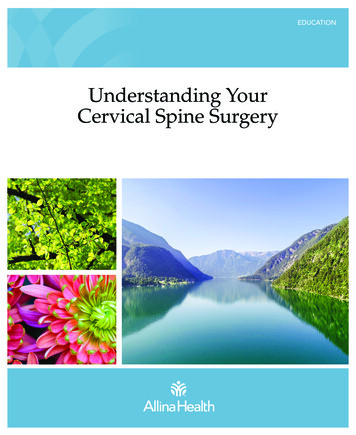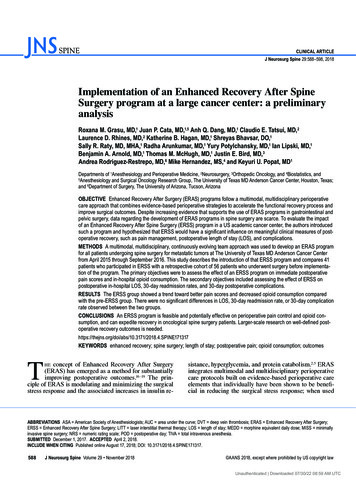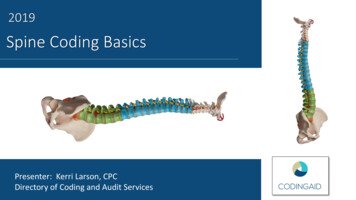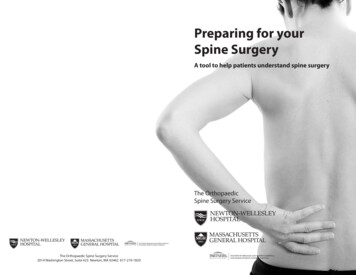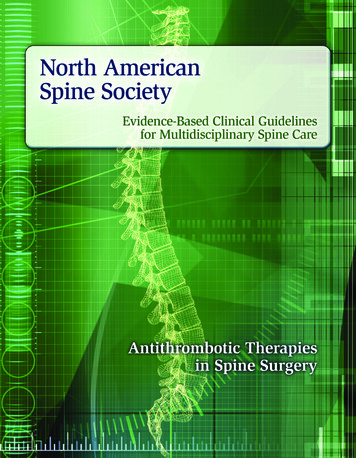
Transcription
NASS Clinical Guidelines – Antithrombotic Therapies in Spine Surgery1North American Spine SocietyEvidence-Based Clinical Guidelinesfor Multidisciplinary Spine CareAntithrombotic Therapies in Spine SurgeryNASS Evidence-Based Guideline Development CommitteeChristopher M. Bono, MD, Committee ChairWilliam C. Watters III, MD, Committee ChairMichael H. Heggeness, MD, PhDDaniel K. Resnick, MD,William O. Shaffer, MDJamie Baisden, MDPeleg Ben-Galim, MDJohn E. Easa, MDRobert Fernand, MDTim Lamer, MDPaul G. Matz, MDRichard C. Mendel, MDRajeev K. Patel, MDCharles A. Reitman, MDJohn F. Toton, MDThis clinical guideline should not be construed as including all proper methods of care or excluding other acceptable methods ofcare reasonably directed to obtaining the same results. The ultimate judgment regarding any specific procedure or treatment is tobe made by the physician and patient in light of all circumstances presented by the patient and the needs and resources particularto the locality or institution.
NASS Clinical Guidelines – Antithrombotic Therapies in Spine Surgery2Financial StatementThis clinical guideline was developed and funded in its entirety by the North American Spine Society (NASS).All participating authors have submitted a disclosure form relative to potential conflicts of interest which iskept on file at NASS.CommentsComments regarding the guideline may be submitted to the North American Spine Society and will be considered in development of future revisions of the work.North American Spine SocietyEvidence-Based Clinical Guidelines for Multidisciplinary Spine CareAntithrombotic Therapies in Spine SurgeryCopyright 2009 North American Spine Society7075 Veterans BoulevardBurr Ridge, IL 60527630.230.3600www.spine.orgISBN: 1-929988-26-5This clinical guideline should not be construed as including all proper methods of care or excluding other acceptable methods ofcare reasonably directed to obtaining the same results. The ultimate judgment regarding any specific procedure or treatment is tobe made by the physician and patient in light of all circumstances presented by the patient and the needs and resources particularto the locality or institution.
NASS Clinical Guidelines – Antithrombotic Therapies in Spine SurgeryI.Introduction . . . . . . . . . . . . . . . . . . . . . . . . . . . . . . . . . . . . . . . . . 4II.Guideline Development Methodology . . . . . . . . . . . . . . . . . . . . 5III.Incidence of DVT/PE in Spine SurgeryA.Unprophylaxed Patient. . . . . . . . . . . . . . . . . . . . . . . . . . . . . . . . . . . . . . . . . . . . . . . . . . . . . . 9B.Prophylaxed Patient . . . . . . . . . . . . . . . . . . . . . . . . . . . . . . . . . . . . . . . . . . . . . . . . . . . . . . . . 153IV. Recommendations Regarding Appropriate Use of AntithromboticTherapies in Spine SurgeryA.Efficacy of Antithrombotic Therapies. . . . . . . . . . . . . . . . . . . . . . . . . . . . . . . . . . . . . . . . . . . 17B.Mechanical Prophylaxis. . . . . . . . . . . . . . . . . . . . . . . . . . . . . . . . . . . . . . . . . . . . . . . . . . . . . . 21C.Chemoprophylaxis. . . . . . . . . . . . . . . . . . . . . . . . . . . . . . . . . . . . . . . . . . . . . . . . . . . . . . . . . 22D.Wound Complications. . . . . . . . . . . . . . . . . . . . . . . . . . . . . . . . . . . . . . . . . . . . . . . . . . . . . . 25E.Risk/Benefit Analysis. . . . . . . . . . . . . . . . . . . . . . . . . . . . . . . . . . . . . . . . . . . . . . . . . . . . . . . . 26V.AppendicesA.Levels of Evidence for Primary Research Questions. . . . . . . . . . . . . . . . . . . . . . . . . . . . . . . 28B.Grades of Recommendations for Summaries or Reviews of Studies. . . . . . . . . . . . . . . . . . 29C.NASS Literature Search Protocol . . . . . . . . . . . . . . . . . . . . . . . . . . . . . . . . . . . . . . . . . . . . . 30D.Literature Search Parameters. . . . . . . . . . . . . . . . . . . . . . . . . . . . . . . . . . . . . . . . . . . . . . . . . 32E.Evidentiary Tables. . . . . . . . . . . . . . . . . . . . . . . . . . . . . . . . . . . . . . . . . . . . . . . . . . . . . . . . . . 39VI.References. . . . . . . . . . . . . . . . . . . . . . . . . . . . . . . . . . . . . . . . . . . 93This clinical guideline should not be construed as including all proper methods of care or excluding other acceptable methods ofcare reasonably directed to obtaining the same results. The ultimate judgment regarding any specific procedure or treatment is tobe made by the physician and patient in light of all circumstances presented by the patient and the needs and resources particularto the locality or institution.
NASS Clinical Guidelines – Antithrombotic Therapies in Spine Surgery4I. IntroductionObjectiveThe objective of the North American Spine Society (NASS) Evidence-Based Clinical Guidelineon Antithrombotic Therapies in Spine Surgery isto provide evidence-based recommendations toaddress key clinical questions surrounding the useof antithrombotic therapies in spine surgery. Theguideline is intended to address these questionsbased on the highest quality clinical literature available on this subject as of February 2008. The goalsof the guideline recommendations are to assist indelivering optimum, efficacious treatment with thegoal of preventing thromboembolic events.Scope, Purpose and Intended UserThis document was developed by the NorthAmerican Spine Society Evidence-based GuidelineDevelopment Committee as an educational toolto assist spine surgeons in minimizing the risk ofdeep venous thrombosis (DVT) and pulmonaryembolism (PE). The NASS Clinical Guideline onAntithrombotic Therapies in Spine Surgery discusses the incidence of DVT/PE in the populationof patients undergoing spinal surgery. Recommendations are made to address the utilization ofchemoprophylaxis and mechanical prophylaxis,with discussion of wound complications and risksassociated with prophylactic measures.THIS GUIDELINE DOES NOT REPRESENTA “STANDARD OF CARE,” nor is it intendedas a fixed treatment protocol. It is anticipated thatthere will be patients who will require less or moreextensive prophylaxis than the average. It is also acknowledged that in atypical cases, treatment fallingoutside this guideline will sometimes be necessary.This guideline should not be seen as prescribing thetype, frequency or duration of intervention. Treatment should be based on the individual patient’sneed and doctor’s professional judgment. Thisdocument is designed to function as a guideline andshould not be used as the sole reason for denial oftreatment and services. This guideline is not intended to expand or restrict a health care provider’sscope of practice or to supersede applicable ethicalstandards or provisions of law.Patient PopulationThe patient population for this guideline encompasses adults (18 years or older) undergoing spinesurgery.This clinical guideline should not be construed as including all proper methods of care or excluding other acceptable methods ofcare reasonably directed to obtaining the same results. The ultimate judgment regarding any specific procedure or treatment is tobe made by the physician and patient in light of all circumstances presented by the patient and the needs and resources particularto the locality or institution.
NASS Clinical Guidelines – Antithrombotic Therapies in Spine Surgery5II. Guideline Development MethodologyThrough objective evaluation of the evidence andtransparency in the process of making recommendations, it is NASS’ goal to develop evidencebased clinical practice guidelines for the diagnosisand treatment of adult patients with various spinalconditions. These guidelines are developed foreducational purposes to assist practitioners in theirclinical decision-making processes. It is anticipatedthat where evidence is very strong in support ofrecommendations, these recommendations will beoperationalized into performance measures.Multidisciplinary CollaborationWith the goal of ensuring the best possible carefor adult patients suffering with back pain, NASSis committed to multidisciplinary involvement inthe process of guideline and performance measuredevelopment. To this end, NASS has ensured thatrepresentatives from medical, interventional andsurgical spine specialties have participated in thedevelopment and review of all NASS guidelines.It is also important that primary care providersand musculoskeletal specialists who care for patients with spinal complaints are represented in thedevelopment and review of guidelines that addresstreatment by first contact physicians, and NASShas involved these providers in the developmentprocess as well. To ensure broad-based representation, NASS has invited and welcomes input fromother societies and specialties.Evidence Analysis Training of AllNASS Guideline DevelopersNASS has initiated, in conjunction with the University of Alberta’s Centre for Health Evidence,an online training program geared toward educating guideline developers about evidence analysisand guideline development. All participants inguideline development for NASS have completedthe training prior to participating in the guideline development program at NASS. This train-ing includes a series of readings and exercises, orinteractivities, to prepare guideline developers forsystematically evaluating literature and developingevidence-based guidelines. The online course takesapproximately 15-30 hours to complete and participants are awarded CME credit upon completion ofthe course.Disclosure of Potential Conflicts ofInterestAll participants involved in guideline developmenthave disclosed potential conflicts of interest to theircolleagues and their potential conflicts have beendocumented for future reference. They will not bepublished in any guideline, but kept on file for reference, if needed. Participants have been asked toupdate their disclosures regularly throughout theguideline development process.Levels of Evidence and Grades ofRecommendationNASS has adopted standardized levels of evidence(Appendix B) and grades of recommendation(Appendix C) to assist practitioners in easily understanding the strength of the evidence and recommendations within the guidelines. The levels ofevidence range from Level I (high quality randomized controlled trial) to Level V (expert consensus).Grades of recommendation indicate the strength ofthe recommendations made in the guideline basedon the quality of the literature.Grades of Recommendation:A: Good evidence (Level I studies with consistentfinding) for or against recommending intervention.B: Fair evidence (Level II or III studies withconsistent findings) for or against recommendingintervention.This clinical guideline should not be construed as including all proper methods of care or excluding other acceptable methods ofcare reasonably directed to obtaining the same results. The ultimate judgment regarding any specific procedure or treatment is tobe made by the physician and patient in light of all circumstances presented by the patient and the needs and resources particularto the locality or institution.
NASS Clinical Guidelines – Antithrombotic Therapies in Spine SurgeryC: Poor quality evidence (Level IV or V studies)for or against recommending intervention.I: Insufficient or conflicting evidence not allowing a recommendation for or against intervention.The criteria for assigning these levels of evidenceand grades of recommendation are the same asthose used by the Journal of Bone and Joint Surgery, the American Academy of OrthopaedicSurgeons, Clinical Orthopaedics and Related Research, the journal Spine and the Pediatric Orthopaedic Society of North America.In evaluating studies as to levels of evidence forthis guideline, the study design was interpretedas establishing only a potential level of evidence.As an example, a therapeutic study designed as arandomized controlled trial would be considereda potential Level I study. The study would then befurther analyzed as to how well the study designwas implemented and significant short comings inthe execution of the study would be used to downgrade the levels of evidence for the study’s conclusions. In the example cited previously, reasons todowngrade the results of a potential Level I randomized controlled trial to a Level II study wouldinclude, among other possibilities, an underpowered study (patient sample too small, variance toohigh), inadequate randomization or masking of thegroup assignments and lack of validated outcomemeasures.In addition, a number of studies were reviewedseveral times in answering different questionswithin this guideline. How a given question wasasked might influence how a study was evaluatedand interpreted as to its level of evidence in answering that particular question. For example, arandomized control trial reviewed to evaluate thedifferences between the outcomes of patients whoreceived antibiotic prophylaxis with those whodid not might be a well designed and implemented6Level I therapeutic study. This same study, however, might be classified as giving Level II prognosticevidence if the data for the untreated controls wereextracted and evaluated prognostically.Guideline Development Process Step 1: Identification of Clinical QuestionsTrained guideline participants were asked to submita list of clinical questions that the guideline shouldaddress. The lists were compiled into a master list,which was then circulated to each member with arequest that they independently rank the questionsin order of importance for consideration in theguideline. The most highly ranked questions, asdetermined by the participants, served to focus theguideline. Step 2: Identification of Work GroupsMultidisciplinary teams were assigned to workgroups and assigned specific clinical questions toaddress. Because NASS is comprised of surgical,medical and interventional specialists, it is imperative to the guideline development process that across section of NASS membership is representedon each group whenever feasible. This also helpsto ensure that the potential for inadvertent biasesin evaluating the literature and formulating recommendations is minimized. Step 3: Identification of Search Terms andParametersOne of the most crucial elements of evidenceanalysis to support development of recommendations for appropriate clinical care is the comprehensive literature search. Thorough assessment ofthe literature is the basis for the review of existingevidence and the formulation of evidence-basedrecommendations. In order to ensure a thoroughliterature search, NASS has instituted a LiteratureSearch Protocol (Appendix D) which has been followed to identify literature for evaluation in guideline development. In keeping with the LiteratureSearch Protocol, work group members have iden-This clinical guideline should not be construed as including all proper methods of care or excluding other acceptable methods ofcare reasonably directed to obtaining the same results. The ultimate judgment regarding any specific procedure or treatment is tobe made by the physician and patient in light of all circumstances presented by the patient and the needs and resources particularto the locality or institution.
NASS Clinical Guidelines – Antithrombotic Therapies in Spine Surgerytified appropriate search terms and parameters todirect the literature search.Specific search strategies, including search terms,parameters and databases searched, are documentedin the appendices (Appendix E). Step 4: Completion of the LiteratureSearchAfter each work group identified search terms/parameters, the literature search was implementedby a medical/research librarian, consistent with theLiterature Search Protocol.Following these protocols ensures that NASS recommendations (1) are based on a thorough reviewof relevant literature; (2) are truly based on a uniform, comprehensive search strategy; and (3) represent the current best research evidence available.NASS maintains a search history in EndNote, for future use or reference. Step 5: Review of Search Results/Identification of Literature to ReviewWork group members reviewed all abstracts yielded from the literature search and identified theliterature they would review in order to address theclinical questions, in accordance with the Literature Search Protocol. Members identified the bestresearch evidence available to answer the targetedclinical questions. That is, if Level I, II and/or IIIliterature is available to answer specific questions,the work group was not required to review LevelIV or V studies. Step 6: Evidence AnalysisMembers of the work group independently developed evidentiary tables summarizing study conclusions, identifying strengths and weaknesses andassigning levels of evidence. In order to systematically control for potential biases, at least two workgroup members reviewed each article selected andindependently assigned levels of evidence to the7literature using the NASS levels of evidence. Anydiscrepancies in scoring have been addressed bytwo or more reviewers. The consensus level (thelevel upon which two thirds of reviewers were inagreement) was then assigned to the article.As a final step in the evidence analysis process,members identified and documented gaps in theevidence to educate guideline readers about whereevidence is lacking and help guide further neededresearch by NASS and other societies. Step 7: Formulation of Evidence-BasedRecommendations and Incorporation ofExpert ConsensusWork groups held Web casts to discuss the evidence-based answers to the clinical questions, thegrades of recommendations and the incorporationof expert consensus. Expert consensus has beenincorporated only where Level I-IV evidence isinsufficient and the work group has deemed that arecommendation is warranted. Transparency in theincorporation of consensus is crucial, and all consensus-based recommendations made in this guideline very clearly indicate that Level I-IV evidence isinsufficient to support a recommendation and thatthe recommendation is based only on expert consensus.Consensus Development ProcessVoting on guideline recommendations was conducted using a modification of the nominal grouptechnique in which each work group memberindependently and anonymously ranked a recommendation on a scale ranging from 1 (“extremelyinappropriate”) to 9 (“extremely appropriate”).Consensus was obtained when at least 80% ofwork group members ranked the recommendationas 7, 8 or 9. When the 80% threshold was not attained, up to three rounds of discussion and votingwere held to resolve disagreements. If disagreements were not resolved after these rounds, norecommendation was adopted.This clinical guideline should not be construed as including all proper methods of care or excluding other acceptable methods ofcare reasonably directed to obtaining the same results. The ultimate judgment regarding any specific procedure or treatment is tobe made by the physician and patient in light of all circumstances presented by the patient and the needs and resources particularto the locality or institution.
NASS Clinical Guidelines – Antithrombotic Therapies in Spine SurgeryAfter the recommendations were established, workgroup members developed the guideline content,addressing the literature which supports the recommendations. Step 8: Submission of the Draft Guidelinesfor Review/CommentGuidelines were submitted to the full Evidencebased Guideline Development Committee, theResearch Council Director and the Advisory Panelfor review and comment. The Advisory Panel iscomprised of representatives from physical medicine and rehab, pain medicine/management, orthopedic surgery, neurosurgery, anesthesiology,rheumatology, psychology/psychiatry and familypractice. Revisions to recommendations were considered for incorporation only when substantiatedby a preponderance of appropriate level evidence. Step 9: Submission for Board ApprovalAfter any evidence-based revisions were incorporated, the drafts were prepared for NASS Boardreview and approval. Edits and revisions to recommendations and any other content were consideredfor incorporation only when substantiated by apreponderance of appropriate level evidence.8 Step 10: Submission for Endorsement,Publication and National GuidelineClearinghouse (NGC) InclusionFollowing NASS Board approval, the guidelineswere slated for publication, submitted for endorsement to all appropriate societies and submitted forinclusion in the National Guidelines Clearinghouse(NGC). No revisions were made at this point inthe process, but comments have been and will besaved for the next iteration. Step 11: Identification and Development ofPerformance MeasuresThe recommendations will be reviewed by a groupexperienced in performance measure development(eg, the AMA Physician’s Consortium for Performance Improvement) to identify those recommendations rigorous enough for measure development. All relevant medical specialties involved inthe guideline development and at the Consortiumwill be invited to collaborate in the developmentof evidence-based performance measures related tospine care. Step 12: Review and Revision ProcessThe guideline recommendations will be reviewedevery three years by an EBM-trained multidisciplinary team and revised as appropriate based on athorough review and assessment of relevant literature published since the development of this version of the guideline.This clinical guideline should not be construed as including all proper methods of care or excluding other acceptable methods ofcare reasonably directed to obtaining the same results. The ultimate judgment regarding any specific procedure or treatment is tobe made by the physician and patient in light of all circumstances presented by the patient and the needs and resources particularto the locality or institution.
NASS Clinical Guidelines – Antithrombotic Therapies in Spine Surgery9III. Incidence of DVT/PE in Spine SurgeryThe body of scientific and clinical literature on thetopic of deep vein thrombosis (DVT) and pulmonaryembolism (PE) is extensive. Either can occur spontaneously or after a risk-enhancing event such as aninjury or a surgical procedure. A variety of factors,including the patient’s health and genetic background,can influence the risk of this life threatening complication.Managing this risk in patients undergoing spinalsurgery can pose substantial challenges. Treatment ofDVT or a PE using anticoagulants in the immediatepostoperative period may potentially lead to catastrophic neurologic decline from epidural bleeding atthe surgical site.A. Incidence of DVT/PE in Unprophylaxed PatientsIn order to appreciate the incidence of these thrombosis-related complications in patients undergoing spinalsurgery without antithrombotic prophylaxis, the workgroup performed a comprehensive literature searchand analysis. The group reviewed 45 articles that wereselected from a search of MEDLINE (PubMed), Cochrane Register of Controlled Trials, Web of Scienceand EMBASE Drugs & Pharmacology that addressedthe incidence and natural history of DVT and PE associated with spinal surgery.Analysis of the questions related to the natural historyof DVT in spinal surgery patients not receiving anyprophylactic therapies was difficult due to a number ofissues.1. Very few studies have been done in recent years inwhich absolutely no prophylaxis was used. Mechanical pumps and/or compressive stockings arewidely and routinely used after spinal surgery sothat studies without such are rare.2. The diagnostic method for DVT and PE varywidely between publications. Older studies reportonly clinically evident thrombotic events. Morerecent studies, in large part due to evolving technology, rely on a variety of different diagnosticmethods including radionuclide scans, venogramsor ultrasound-based imaging. Thus, comparisonof outcomes between different studies that usedistinctly different diagnostic criteria is of questionable validity.3. The patient populations addressed in the worldliterature vary widely. The study groups variedin age, ethnicity (potentially influencing geneticsusceptibility), magnitude and length of surgery,and postoperative mobilization, all of which mightinfluence the risk for thromboembolic disease.For example, it is well-established that bed rest isa risk factor for DVT. However, the pace at whichpatients are mobilized after spinal surgery varieswidely. Mobilization protocols are rarely reportedin detail in spine surgical studies.Because of these issues, the work group was unableto definitively answer the posed questions related toincidence of DVT/PE in spinal surgery patients not receiving prophylactic antithrombotic therapies. However, the work group felt that several important suggestions can be made based on the literature reviewed.These are included below along with a detailed analysis of the small subset of papers that met the guideline’s inclusion criteria and provided information thatwas germane to the discussion of incidence in thispatient population.This clinical guideline should not be construed as including all proper methods of care or excluding other acceptable methods ofcare reasonably directed to obtaining the same results. The ultimate judgment regarding any specific procedure or treatment is tobe made by the physician and patient in light of all circumstances presented by the patient and the needs and resources particularto the locality or institution.
NASS Clinical Guidelines – Antithrombotic Therapies in Spine SurgeryWhat is the overallrate (symptomatic andasymptomatic) of DVT or PEfollowing elective spinal surgerywithout any form of prophylaxis?What are the relative rates ofclinically symptomatic DVT or PE(including fatal PE) without anyform or prophylaxis followingelective cervical, thoracic, andlumbar surgery?Work Group Conclusions/Suggestions:1. Deep vein thrombosis and subsequentpulmonary embolus can occur following spinalsurgery, which in turn can lead to morbidityand death. Anyone participating in the careof spinal surgery patients should be aware ofthese conditions as known potential events.2. The incidence of DVT and PE in patientsundergoing spinal surgery likely variesaccording to the magnitude of the surgery andperioperative mobilization.3. The use of “historical controls” to addressthe incidence of DVT or PE in a perioperativepopulation is probably not appropriate.4. Clinical examination alone is not areliable method to confirm the diagnosisof a DVT. Objective diagnostic methods,such as venography or Doppler ultrasound,should be used to confirm a suspected DVTin postoperative spine patients. Futurestudies to characterize the incidence ofDVT in postoperative spine patients shoulduse objective diagnostic methods such asvenography or Doppler ultrasound.10Gruber et al18 performed a prospective comparativestudy to determine the incidence of bleeding complications in patients undergoing lumbar disc surgerytreated with minidose heparin-dihydroergotamine(DHE) or placebo. Of the 50 patients included in thestudy, 25 received 2500IU heparin-DHE twice dailyand 25 were assigned to the placebo group. Injectionswere administered two hours preoperatively, withpostoperative administration at 12-hour intervals forat least seven days or until the patient was dischargedfrom the hospital. Of the 25 assigned to the controlgroup, five had received heparin at another hospital and were excluded from the analysis. Surgeonsreported bleeding and, if clinically suspected, DVTwas diagnosed by phlebogram, plethysmography,Doppler ultrasound or I125 fibrinogen test. If a PEwas suspected, a chest radiograph, ECG, ventilationperfusion scan or pulmonary angiogram was obtained.The authors reported no clinically evident DVT orPE events in this small series of consecutive patients.The authors noted increased intraoperative bleeding in24% (6/25) of patients in the heparin-DHE group and28% in the placebo group, a difference that was notstatistically significant.In critique of this study, diagnostic methods for DVTwere not standardized and only conducted whenprompted by clinical suspicion. Furthermore, patientnumbers were quite low and the definition of “lumbar disc operations” was unclear. Due to these methodological limitations, this potential Level II studyprovides Level III evidence of a low risk of DVT/PEin patients undergoing lumbar disc surgery.Joffe et al20 reported results of a prospective case series investigating the incidence of DVT in patients undergoing elective neurosurgical procedures. Of the 23neurosurgical patients included in the study, only 10were spinal cases. All patients were screened daily forthe duration of their hospital stay (which was at leastseven days) for DVT with an I125 fibrinogen test andDoppler ultrasound. The authors reported that 60%of the spinal patients (6/10) developed asymptomaticpostoperative DVT. They concluded that neurosurgical patients are at risk for DVT and that these patientsThis clinical guideline should not be construed as including all proper methods of care or excluding other acceptable methods ofcare reasonably directed to obtaining the same results. The ultimate judgment regarding any specific procedure or treatment is tobe made by the physician and patient in light of all circumstances presented by the patient and the needs and resources particularto the locality or institution.
NASS Clinical Guidelines – Antithrombotic Therapies in Spine Surgeryare often asymptomatic. Based on their findings, theauthors further suggested that DVT will be underdiagnosed by clinical criteria alone.In critique, this was a very small study consisting ofonly a few spinal patients without details about thetype and extent of spine surgery. Due to these weaknesses, this potential Level IV study provides LevelV evidence that asymptomatic DVT is not uncommonin a nonselect group of patients undergoing electivespinal surgery likely followed by prolonged periodsof bed rest, an ass
The objective of the North American Spine So-ciety (NASS) Evidence-Based Clinical Guideline on Antithrombotic Therapies in Spine Surgery is to provide evidence-based recommendations to address key clinical questions surrounding the use of antithrombotic therapies in spine surgery. The guideline is intended to address these questions
